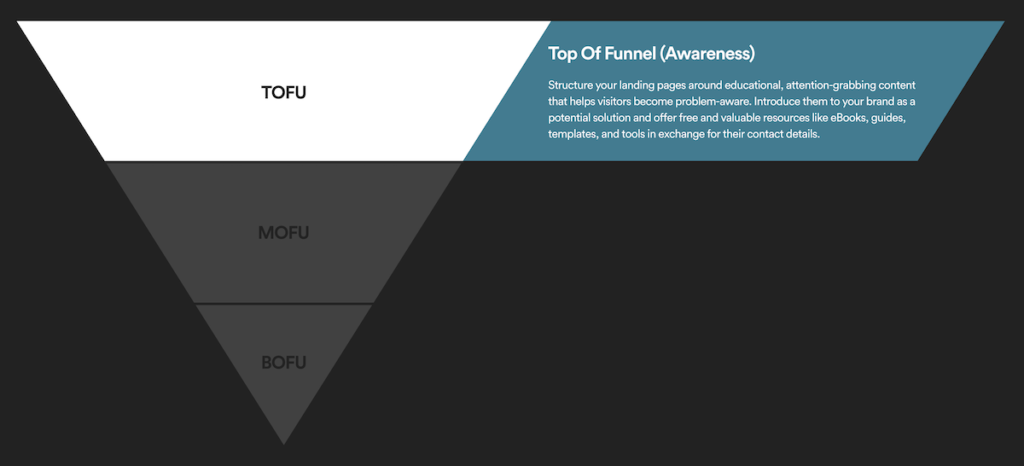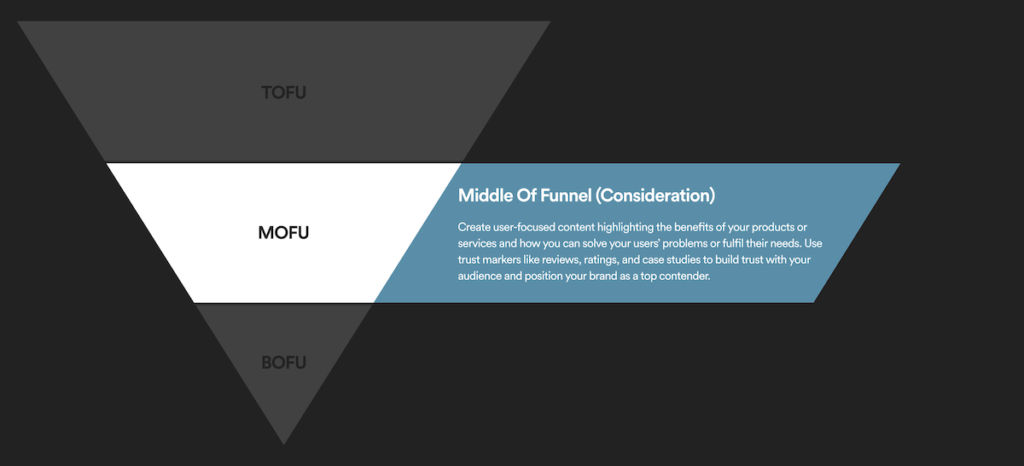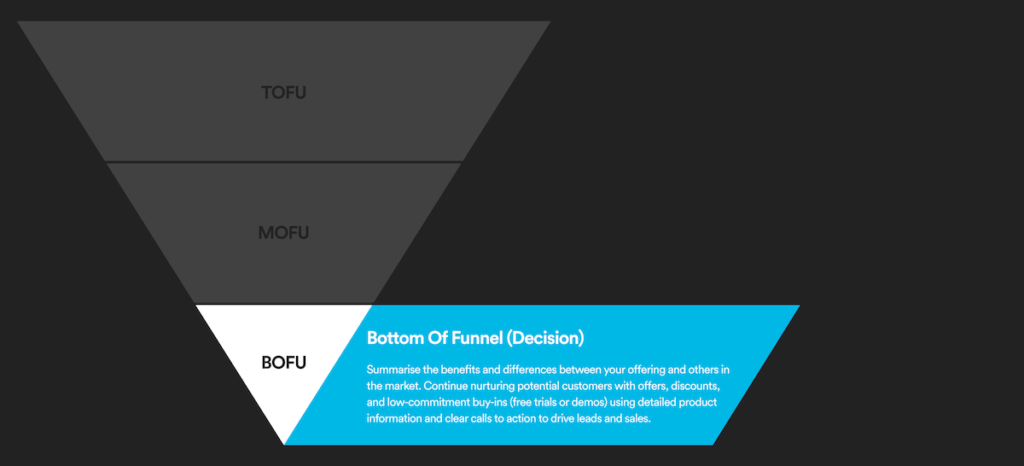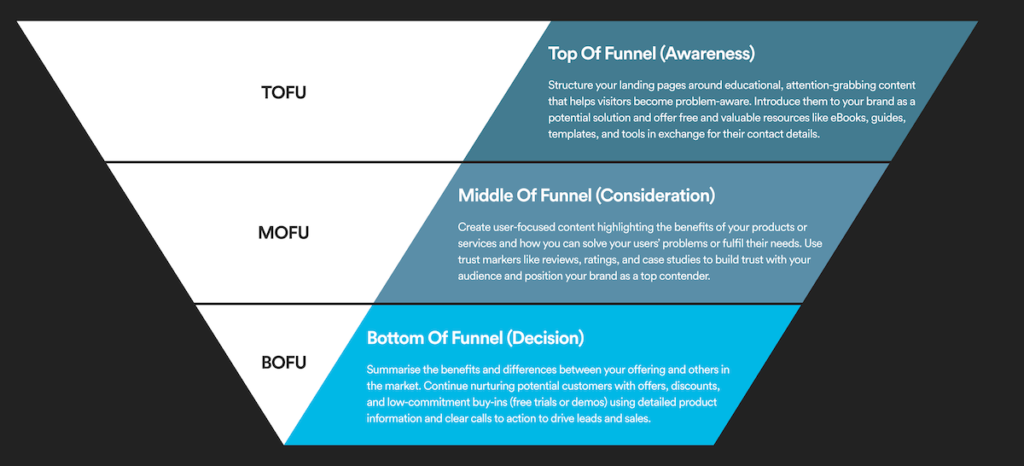Landing Page Optimisation: How to Generate More Conversions
Table of Contents
Landing page optimisation is still massively overlooked by a lot of companies.
Each month, we get multiple enquiries asking questions like this one or similar to it… 👇
“We’re running some Google Ads campaigns, and we’re seeing loads of clicks and traffic, but we’re not getting any conversions – can you take a look and tell us what our agency is doing wrong?”
Nine times out of ten, we reply, “Well, if your ads are working and driving traffic, then your landing pages sound like the problem.”
You see, a lot of business owners forget that getting people onto their websites is the easy part.
The hardest part is keeping those people interested, nurturing and guiding them through your pages, and getting them to fill out a form or buy your products.
That’s where landing page optimisation comes in.
Once your marketing campaigns are set up and performing well, you can optimise your landing pages to maximise your results and reduce the number of potential customers who slip through the cracks.
Keep reading for more info on landing page optimisation, tips on how to optimise your landing pages effectively, and answers to some of the most frequently asked questions about landing page optimisation.
What is landing page optimisation?
Landing page optimisation is the process of tweaking and testing different page layouts, designs, content, and calls to action to keep people on your website for longer and get them to take the conversion actions you want them to take.

To optimise your landing pages effectively, you need to take a holistic approach, combining SEO, UX, and CRO into your strategy to increase user engagement, conversions, and revenue.
There’s no one-size-fits-all approach to landing page optimisation. You need to understand your audience’s wants and needs if you want to create pages that drive them to take action.
Before you make significant changes to your landing pages, you need to consider who the page is for and what stage of your marketing funnel they are in.
Consider where people are in your marketing funnel
If you’re unfamiliar with the marketing funnel stages, there are typically three stages: Top of Funnel, Middle of Funnel, and Bottom of Funnel.
Each stage represents where the visitor is in their buying journey, helping determine the content and messaging that is best to connect with them at their current stage and nurture them through the following stages and, ultimately, to converting.
Here’s a breakdown of each stage and how they can influence your landing page optimisation strategy.
Top of Funnel (Awareness)
At the top of the funnel, also called the awareness stage, people are just becoming aware of their needs or problems but often aren’t aware of your company or what you provide.
At this stage, your landing pages serve as the initial introduction to your brand and a way to demonstrate your expertise. You need to address visitors’ concerns and make them aware of potential solutions to their problems.
The goal here isn’t to turn them into paying customers but to be genuinely helpful, position your company as a potential solution, and collect their contact details in exchange for an eBook, guide, or other resource.

Middle of Funnel (Consideration)
In the middle of the funnel, known as the consideration stage, your audience is aware of their problems and considering potential solutions.
At this stage, you need to demonstrate how your products or services can meet your visitors’ specific needs while building trust and providing value that nurtures them through to the next stage of the funnel.
On your landing pages, this means creating benefit-focused content that doesn’t just explain what you do but tells your audience what the benefits are to them and how you can solve their issues.
To build trust, you need to include case studies and customer reviews. To provide value, offer an easy next step that doesn’t require a big commitment, like booking a discovery call, requesting a quote, or creating an account on your website.
Like the top of the funnel, your focus should be on adding value to your visitors and nurturing them through to the next stage of the funnel, not just converting them into customers.

Bottom of Funnel (Decision)
At the bottom of the funnel, or the decision stage, your audience is ready to buy.
By this point, they should know your brand well and will be comparing your offerings against other options they’ve found to determine which is the best fit.
By running retargeting and email campaigns to people at the bottom of your funnel, you can direct them to your landing pages, specifically designed to position your business as the obvious choice.
To seal the deal, your landing pages should summarise the benefits of choosing your products/services, compare them with other options they’re likely considering, and offer clear and incentivised calls to action like free trials, demos, or discounts.

Create optimised landing pages for each stage of the funnel
By creating targeted marketing campaigns and landing pages designed to engage with potential customers and nurture them at each step of your marketing funnel, you can improve your website conversion rates, marketing ROI, and revenue.

Once you’ve created these campaigns and landing pages for each stage, the next step is to conduct continuous landing page optimisation and monitoring.
Tips for improving your landing page optimisation
Do your research before making changes
Understanding your visitors, what they’re looking for, and what they like to see is essential for making informed changes on your landing pages.
Before doing any landing page optimisation, you should thoroughly research user behaviours, interests, objectives, and pain points.
This research should cover areas like:
- User demographics: Understand who your website visitors are.
- User intent: Find out what users look for when visiting your landing page.
- User engagement: Analyse user engagement metrics such as session duration, bounce rate, and scroll depth.
- Conversion funnel analysis: Look at the steps visitors go through before converting and identify drop-off points.
- Competitor analysis: Analyse competitor landing pages to identify strengths and weaknesses.
- Keyword research: Identify relevant keywords to optimise your landing page for search engines.
- Best practices: Learn what SEO, UX, and Copywriting best practices you should follow.
The data gathered from these types of research will help you identify weak points in your user journey, opportunities to improve your landing pages, and a general guideline on the practices you need to follow when making changes to your page.
Improve your landing page’s technical performance
The loading speeds of your landing pages can have a massive impact on engagement rates and conversions.
Slow loading speeds create a terrible user experience. If your landing page takes more than a few seconds to load, users are more likely to leave without converting.
It’s also a massive risk to your organic SEO and paid advertising performance.
Google presents searchers with accurate information from websites that perform well. If your page speeds are below what your users would expect, you’ll notice a drop in your ranking position.
On the paid ads side, the performance and cost-per-click of your Google Ads campaigns rely heavily on your quality score. Your landing page performance can have a big impact on this score, limiting campaign performance and driving up your cost-per-click.
Plus, Google charges you when someone clicks on your ad, not when your landing page loads. If your bounce rate is high, you might be paying for visitors who left before your page even loaded.
You can optimise your landing page’s loading speed by:
- Compress images and videos to reduce load times.
- Reduce the number of elements on your pages that require HTTP requests.
- Implement lazy-loading images to delay off-screen loading and reduce load times.
- Use asynchronous loading so JavaScript loads in the background while the rest of the page loads.
- Use browser caching to speed up load times for returning visitors.
- Follow Google’s Core Web Vitals guidelines to optimise loading speeds, interactivity, visual stability, and user experience.
Optimising your landing pages for performance will help reduce your bounce rate, increase engagement and conversions, and improve your overall SEO and paid advertising performance.
Check out our other article on how to improve your site speed.
Be consistent with your messaging and language
Being consistent with our messaging builds trust and credibility with your audience.
Ensure your language, tone, and message align across all touchpoints, including social media and ad campaigns. Inconsistent messaging can create confusion, disengagement, and a negative perception of your brand, harming more than just your conversion rate.
Here are a few tips to follow for creating and maintaining consistency:
- Ensure the language and tone across your landing page align with your brand’s identity and values.
- Coordinate your messaging across all your marketing channels, including social media, email campaigns, and advertisements, to create a cohesive brand experience.
- Create and stick to brand guidelines that outline specific rules for messaging, including preferred language, voice, and style. This helps maintain a unified brand identity across all audience touchpoints.
- Experiment with storytelling elements that reflect your brand’s narrative and values in the messaging. This can create an emotional connection with your audience that can drive.
- Review and update your messaging regularly to ensure it remains relevant and aligned with your audience’s needs, interests, and new market trends.
Optimise your landing pages for mobile devices
With over half of all website traffic coming from mobile devices and Google now taking a mobile-first approach to ranking pages, you can’t afford to neglect mobile optimisation on your landing pages.
Making sure your landing pages are optimised for mobile visitors will improve their experience and help boost your SEO, as Google prioritises mobile-friendly web pages in search results.
To ensure your landing page is optimised for mobile devices, these are the areas you need to look at:
- Responsive layout: Create a landing page layout that seamlessly adapts to different screen sizes and resolutions. Make sure you test your landing page across different devices.
- Mobile-friendly menus: Use mobile-friendly navigation menus, like hamburger menus, so that mobile users can easily navigate between pages and content sections
- Optimised fonts and text: Check that the fonts on your website are easily readable on mobile devices, and adjust the text size, spacing, and line height where needed.
- Touch-friendly calls-to-action and forms: Use buttons, links, and other touch-friendly interactive elements for mobile device users. Also, check that your forms are easy to use on mobile, and remove or adjust fields if necessary.
- Mobile load speeds: Fast loading speeds are essential for your UX and SEO. Make sure your pages load quickly to reduce bounces and increase conversions.
- Cross-browser compatibility: Test your landing page design across different mobile browsers to ensure it loads and performs consistently across all platforms.
Provide a great user experience
If you want your landing page visitors to convert into leads and customers, you need to create an enjoyable user experience.
The job of your user experience is to delight your users and help them reach their goals or find what they’re looking for quickly and easily.
So, if you think consciously about how you can create a website that helps your users effortlessly find solutions to their problems and use that level of thinking in the design, structure, and messaging of your landing pages, people are likely to stick around on your website for longer and complete conversion actions like filling out a form or downloading a brochure.
You can learn more about the importance of User Experience in this blog post.
Here are a few areas of UX you should consider when creating your landing page optimisation strategy:
- User journey: Think about what your users are looking for and want to achieve, and create a user journey that prioritises helping them reach their goals without any issues or frustration.
- Design and layout: Create a visually appealing design and structure that is clear and easy to follow. Avoid overdoing the design, as this can overstimulate users and make your website difficult to use.
- Visual hierarchy: Establish a clear and consistent visual hierarchy using different font sizes, colours, and styles that clearly distinguish different content sections and containers.
- Interactivity: Ensure that all buttons, links, animations, forms, and other interactive or reactive elements work correctly and don’t cause visual issues.
- Speed & Responsiveness: Make sure your landing pages load quickly and perform consistently across all devices and browsers.
- Accessibility: Follow best practices for web accessibility to make your website easy to use for everyone in your audience. Also, avoid jargon and overly technical language that some users might not understand.
Streamlines your CTAs and forms
Your calls-to-action and forms are the final step before someone converts into a lead.
Even if the rest of your landing page optimisation is spot on, if your calls to action are poorly structured, badly worded, or confusing, you’ll struggle to generate conversions.
If you can create the right balance of benefit-focused content, streamlined calls to action, and forms that follow best practices, you’ll create a super smooth conversion flow that will lead to more conversions from pre-qualified visitors.
Here are some of the best practices you should follow for your forms and calls to action.
Call-to-action best practices:
- Use clear, benefit-focused copy, e.g. ‘Download your free guide’ or ‘Start your free trial’
- Make them easy to see with contrasting colours and positioned above the fold so users don’t have to scroll to see a call-to-action
- Only use urgency or scarcity when necessary – don’t say, ‘Only 5 left in stock’ if that’s not the case
- Use consistent messaging and language across all calls to action
- A/B test different CTA positions, copy, and styles
Form best practices:
- Keep forms short and only ask for the information you need
- Test your forms to ensure they’re mobile-friendly and easy to complete
- Clearly label fields and include easy-to-follow instructions
- Make sure opt-outs and opt-ins are clearly worded and aren’t misleading
- Have clear error messaging and instructions
- Make it clear what will happen after the user has submitted their form – will they remain on the page or be redirected to another one?
Continuously test and improve your pages
It’s important to remember that landing page optimisation isn’t just a ‘one and done’ project. It’s a continuous process you need to review regularly and keep up with as user needs, behaviours, and trends change.
So, regularly monitor your landing page performance and make further adjustments when needed.
If things are going great and you’re getting more conversions than you know what to do with, then you’re better off leaving things as they are – as the saying goes, if it ain’t broke, don’t fix it.
But, if you start to see a drop in engagement or conversions, try exploring new designs, updating your content, and conducting A/B tests to optimise your performance.
FAQs about landing page optimisation
How do I check if my landing page is optimised or not?
The easiest way to tell whether you need to conduct some landing page optimisation is by looking at your engagement and conversion rates.
The average website engagement rate is around 60% – 70%, and the average conversion rate is around 3.3% – however, this can vary from industry to industry.
If your engagement and conversion rates are very low, you’re noticing a lack of leads or form completions, and your data shows people only spend a few seconds on your landing pages before leaving your landing page experience needs some work.
Should landing pages be optimised for SEO?
Like most questions relating to SEO, the answer is: “It depends.”
If you want people to find your landing page in organic search results, then you should absolutely have an SEO strategy in place that includes your landing pages.
If you only want traffic from a specific marketing campaign and not organic traffic, then you’ll need to add a ‘noindex’ tag to your landing page’s code to stop Google indexing from indexing that page so that no one can find it without a direct link or typing out the full URL.
This might be the case if you’re running an outbound email campaign with a dedicated landing page that only the email recipients can access. In that situation, you wouldn’t need to implement a keyword strategy or optimise things like your meta description.
However, we always recommend following SEO best practices, even if the page isn’t indexed on Google.
Why? Because some platforms, like Google Ads, will consider those best practices when judging your landing page experience and quality score.
If your landing page’s Core Web Vitals score is poor and pages load slowly, it could affect your ad performance.
What is not recommended for landing page optimisation?
In your landing page optimisation strategy, the biggest thing to avoid is basing your decisions on your preferences and gut feeling rather than audience research and actual data.
What you think will work and what actually works for your audience might look entirely different.
If you have clear and accurate data, always use it to inform your decisions.
Rather than thinking, “I want this part of the page to look like this, and I want this section to talk about that.” … use your data and your understanding of your audience to think about what they want and need to see.
How many keywords should I target for each landing page?
Like any other page you’re trying to rank, you shouldn’t dilute your pages by targeting too many keywords.
Carry out some keyword research using a tool like Semrush to find highly relevant keywords with enough traffic, and choose one keyword as the primary one you will target, as well as some secondary keywords that you still want to include somewhere on the page.
You should then naturally include that primary keyword in your landing page’s titles, headings, anchor text, and written content.
For example, let’s say your primary keyword is ‘Accountancy services in Hampshire’; you might also want to include keywords like ‘Financial services Hampshire’ or ‘Hampshire accountants’ somewhere on the page.
How do I know if my landing page optimisations are working?
It’s essential to monitor your landing page performance to understand the impact your landing page optimisations are having.
To do this effectively, you should benchmark your engagement metrics before making any changes to your landing pages.
Take note of your current engagement rate, session duration, and conversion rates so that when you start making changes, you can see whether they have a positive or negative impact on user engagement.
If your changes are working, great, keep it going. If not, then you might need to adjust your approach.
Ready to get more conversions from your landing pages?
Our in-house Marketing, UX, and Web specialists can handle the entire creation and landing page optimisation process for you, creating stunning landing pages that deliver a great user experience for your visitors and more conversions and revenue for your business.
Sound good? Speak to one of our specialists to learn more.

